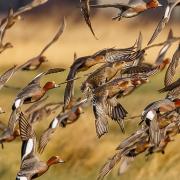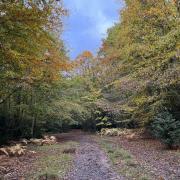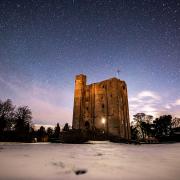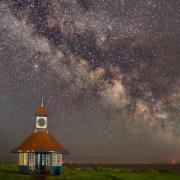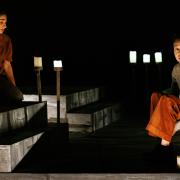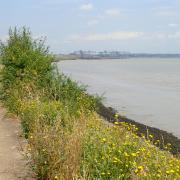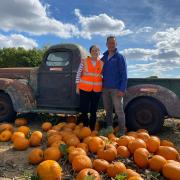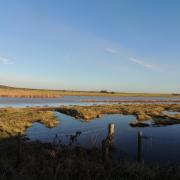You wouldn’t know the M25 runs through the parish as you enjoy this stroll through quiet, agricultural countryside.
1. Take the footpath on the track beside Alec’s restaurant (formerly the Green Man pub). Continue straight, past wooden field gates, then fork left, past a concrete block, keeping the hedgerow on your right. Pass another concrete block into the next field, still with the hedgerow on the right, then at the end of the field veer right, following a muddy track along a wide grassy ride. A wide culvert heads out into another arable field; turn left and then left again, into yet another field. Turn right and follow the field edge, to a footbridge, then straight on along the grassy verge of a tapering field at the apex of which the path enters a short wooded section before emerging onto a lane beside a fingerpost.
2. Turn right along the lane, proceeding with due regard to the vehicular traffic. Turn right into the lane signed as ‘Dudbrook Road Ladys Hill’; this is much quieter, indeed the only sound I heard while walking here was the overhead mewing of buzzards. After 700 metres the lane bends right but take the path which leads straight on, marked by two concrete blocks. The view of rolling hills beyond the bracken in the foreground here (with fingerpost protruding) is strangely reminiscent of the West Country. The route follows an ancient track downhill, before veering right onto a grassy path, weaving between ponds and willow and oak trees, also passing a lovely mature hawthorn.

3. Emerge onto more arable fields. Keep straight, on the grass verge with the hedgerow and a stream on your right and the fields sloping up to the horizon on your left. On one bend a large oak stands obstinately alone, invading the edge of the field. At the end of the field turn right; pass through a wooden kissing gate then up a slope, bend left and the path leads to a set of steep steps descending to a lane. Turn left onto the lane then sharp right, onto Church Road. Pass Little Beaconhill Farm and some houses.
4. On the right, just past number 4, Church Road, a wooden fingerpost indicates a footpath. Follow it, across the field to a bridge, and then straight on to a stile leading into the next field. Keep straight then, at a waymarker post on a corner, follow the crossfield path leading down to a footbridge over a stream. On the other side the path heads back uphill across the field, a pair of mature trees being all that remains of an old hedge-line. At the road, turn left then right onto Navestock Side at the signposted junction. Royds Lane, on the left, then offers a route avoiding the traffic. After 200 metres turn right onto Green Lane, then right again onto the footpath behind the cricket pavilion, leading back to the starting place.
Compass Points
Distance: 4.4 miles (7.1km).
Starting point: Navestock Village Hall, Navestock Side, CM14 5SD, grid reference TQ563975.
Access: The village hall car park is only open when the hall is open, so it is best not to use it, however it is possible to park just outside the entrance without blocking it. There is no regular bus service to Navestock Side but there is a well-served bus stop on Ongar Road (Old Crown Lane, Pilgrim’s Hatch) within easy walking distance (www.essexbus.info).
Map: OS Explorer 175 Southend-on-Sea & Basildon.
Refreshment: Alec’s Restaurant is beside the starting point. There are no pubs or cafés in Navestock but there are a couple of pubs – The Eagle and The Shepherd Inn – in nearby Kelvedon Hatch. There is also a village shop nearby at the corner of Ongar Road and Church Road (grid reference TQ569989; postcode CM14 5TJ).
Places of interest: Despite its proximity to London – indeed the parish is actually divided into two parts by the M25 motorway – Navestock remains primarily rural and quiet. The parish church, just west of the walk route, retains Norman features but is noted for the intricacy of the interior woodwork supporting the tower. There are several memorials to members of the Waldegrave family, one of whom – James, the 2nd Earl – can arguably claim to have been one of the shortest-serving British Prime Ministers, having nominally held the post for five days in June 1757. A more modern (yet geologically ancient) monument can be found just to the south at the junction of Horseman Side and Old Road where a large boulder of ‘puddingstone’ – brought here as a passenger by a glacier during the Ice Age – was erected on a plinth to mark the Millennium. Also, just to the south, those hankering for more of the great outdoors may enjoy the attractive little Woodland Trust reserve called ‘The Mores’, a mixed woodland with something to offer at any time of year. Parking and access can be found from the vicinity of the Victorian church at Bentley (Mores Lane, grid reference TQ566966; postcode CM14 5RZ), itself well worth a visit if time permits; although relatively modern it is in the gothic revival style and has some beautiful stained glass. Less than a mile to the north of the walk, on the Ongar Road, lies the Kelvedon Hatch ‘Secret’ Nuclear Bunker, amusingly referred to as such on local road signs and Ordnance Survey maps. It is now a visitor attraction of course (check online for opening times).




